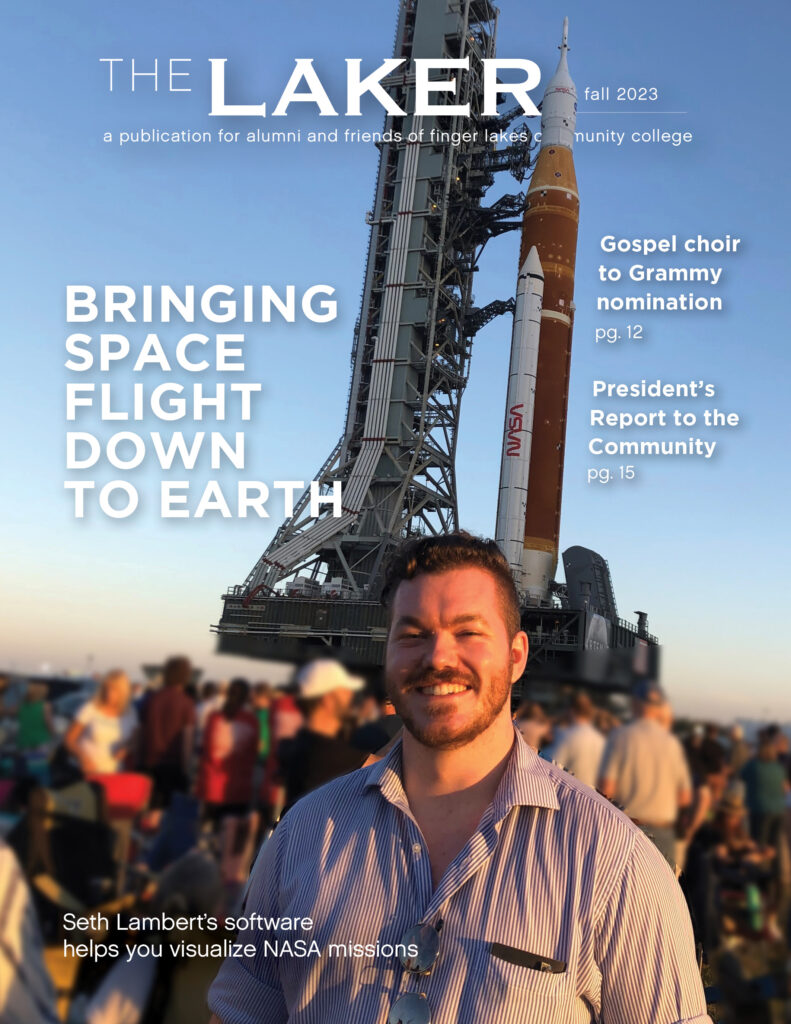The cover story of the fall Laker magazine features Seth Lambert ’18, who used his game design skills to help people understand NASA’s Artemis missions

The email said Seth Lambert ’18 had just six hours to apply for an internship with a NASA contractor.
It was 2019, more than a year after he transferred from FLCC to Rochester Institute of Technology. As part of his bachelor’s program, he had applied for more than 100 other internships with no luck. The contractor, Universities Space Research Association, needed to fill this post quickly.
Soon Seth was headed to Johnson Space Center in Houston for an eight-month internship that led to a full-time job working as a contractor for the Orion program on the Artemis missions.
Artemis consists of a series of progressively more complex flights designed to take humans back to the moon and beyond. The first flight, Artemis I, sent an uncrewed craft in orbit around the moon.
Seth used skills developed at FLCC and RIT to create AROW, short for Artemis Real-time Orbit Website. When the Orion spacecraft blasted off Nov. 16, 2022, the AROW website allowed people to track its progress in relation to the Earth, moon and sun.
AROW, he explained, “listens to an enormous amount of data coming down from space and uses that to create a very literal visualization of what’s going on, so this is as if you were traveling through space alongside Orion. The goal was to make something that wasn’t just for internal use but that could communicate the mission to everybody.”
With Orion’s successful flight and splashdown in the Pacific on Dec. 11, Seth’s attention turned to the next phase, Artemis II, a lunar flyby with a human crew in late 2024.
“Artemis II is a slightly different mission,” he added. “It’s going to be much shorter, and the flight plan is also quite different, so there’s a lot of work necessary to bring the software up to date for the new mission. We’re adding new features and working on other exciting ways for people to visualize and track future missions.”
Family connection
Seth’s grandfather, Hubert “Norris” Lambert, was a contractor for the space agency during the shuttle program.
“I unfortunately never met him, but I grew up hearing stories about when he worked at NASA and that was always something that sounded so fantastic.”
Seth, too, is a contractor. His internship involved designing a kiosk application for conventions and museums to familiarize users with the Orion spacecraft. He then developed a Twitter bot that could take telemetry data from a spacecraft and generate text for a tweet.
When his internship ended, NASA contractor MORI Associates hired him full-time. He has continued the work as an employee of Logical Innovations and Barrios Technology. Still, Seth is part of a larger NASA culture of exploration.
“I’ve only worked at Johnson Space Center and in pretty narrow fields, but my experience of NASA has been that it’s a terrific community of learning,” he said. “One of the things that I really appreciated as an intern was just how willing everybody was to talk about what they’re working on and to hear about what you’re working on. There’s just this kind of communal excitement around the work being done.”
Learning to be curious
Both of Seth’s degrees are in game design, a field he selected after finishing high school in Seattle. His family moved east when his mom, Lori Vail, became a humanities instructor at FLCC. He applied to RIT first but couldn’t swing it financially, then learned about FLCC’s transfer arrangement with RIT.
“I really didn’t know what to expect going into it. I had very, very limited experience with any kind of programming in high school. I quickly found I enjoyed the FLCC coursework and was able to do well.”
He credits his success in part to Dave Ghidiu, assistant professor in computing sciences.
“I really appreciated his style of teaching. He encouraged all of us to foster a sense
of creativity and curiosity. If we didn’t know what a button did, press it.”
His advice to students today borrows from his FLCC experience.
“So many times I’ve learned something just by getting curious and reading a Wikipedia page. Then that led to some creative thought or some technical thought that has helped me in my work or in my personal projects. If you find yourself wondering what something does or how it works, pursue it because there may be an opportunity to use that knowledge later.”
That, and check your email often, because as Seth put it, “Life can change so fast.”

